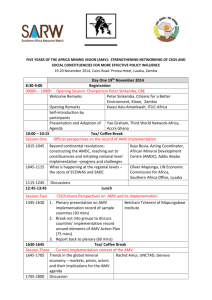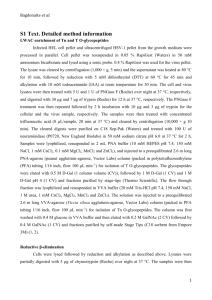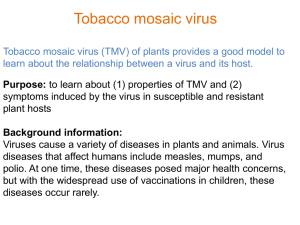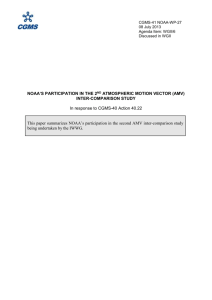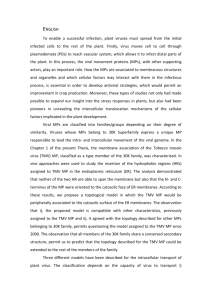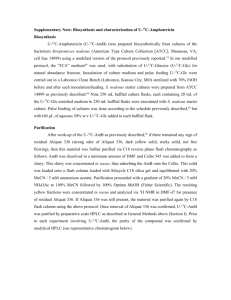INSTRUCTIONS TO AUTHORS
advertisement
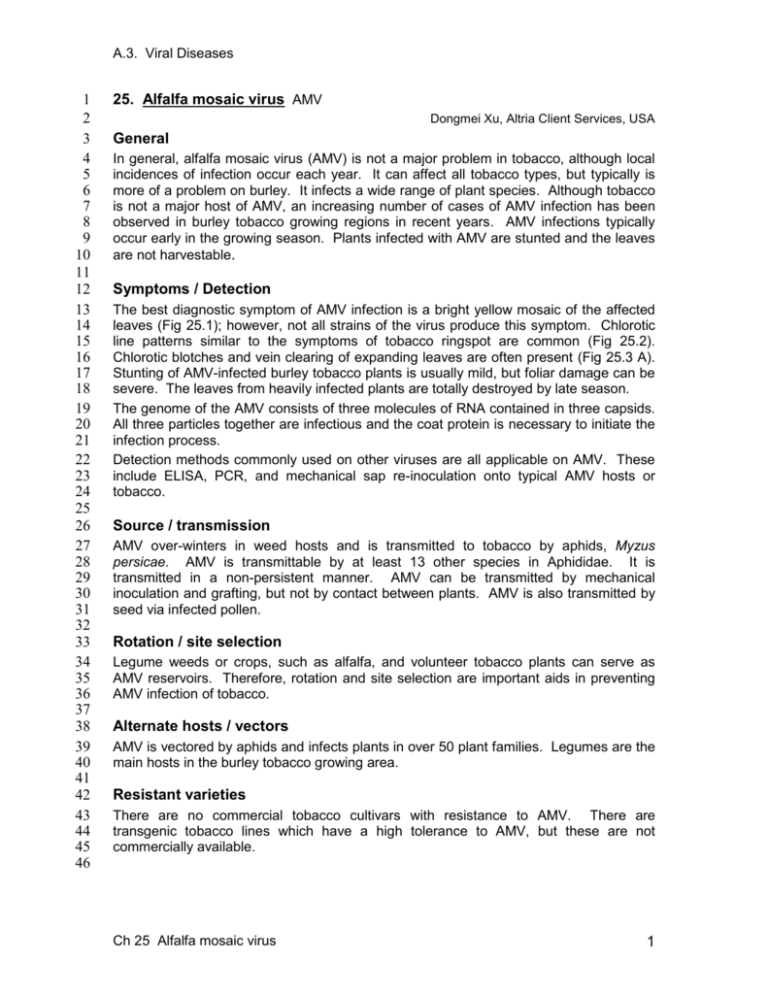
A.3. Viral Diseases 1 2 3 4 5 6 7 8 9 10 11 12 13 14 15 16 17 18 19 20 21 22 23 24 25 26 27 28 29 30 31 32 33 34 35 36 37 38 39 40 41 42 43 44 45 46 25. Alfalfa mosaic virus AMV Dongmei Xu, Altria Client Services, USA General In general, alfalfa mosaic virus (AMV) is not a major problem in tobacco, although local incidences of infection occur each year. It can affect all tobacco types, but typically is more of a problem on burley. It infects a wide range of plant species. Although tobacco is not a major host of AMV, an increasing number of cases of AMV infection has been observed in burley tobacco growing regions in recent years. AMV infections typically occur early in the growing season. Plants infected with AMV are stunted and the leaves are not harvestable. Symptoms / Detection The best diagnostic symptom of AMV infection is a bright yellow mosaic of the affected leaves (Fig 25.1); however, not all strains of the virus produce this symptom. Chlorotic line patterns similar to the symptoms of tobacco ringspot are common (Fig 25.2). Chlorotic blotches and vein clearing of expanding leaves are often present (Fig 25.3 A). Stunting of AMV-infected burley tobacco plants is usually mild, but foliar damage can be severe. The leaves from heavily infected plants are totally destroyed by late season. The genome of the AMV consists of three molecules of RNA contained in three capsids. All three particles together are infectious and the coat protein is necessary to initiate the infection process. Detection methods commonly used on other viruses are all applicable on AMV. These include ELISA, PCR, and mechanical sap re-inoculation onto typical AMV hosts or tobacco. Source / transmission AMV over-winters in weed hosts and is transmitted to tobacco by aphids, Myzus persicae. AMV is transmittable by at least 13 other species in Aphididae. It is transmitted in a non-persistent manner. AMV can be transmitted by mechanical inoculation and grafting, but not by contact between plants. AMV is also transmitted by seed via infected pollen. Rotation / site selection Legume weeds or crops, such as alfalfa, and volunteer tobacco plants can serve as AMV reservoirs. Therefore, rotation and site selection are important aids in preventing AMV infection of tobacco. Alternate hosts / vectors AMV is vectored by aphids and infects plants in over 50 plant families. Legumes are the main hosts in the burley tobacco growing area. Resistant varieties There are no commercial tobacco cultivars with resistance to AMV. There are transgenic tobacco lines which have a high tolerance to AMV, but these are not commercially available. Ch 25 Alfalfa mosaic virus 1 A.3. Viral Diseases 47 48 49 50 51 52 53 54 55 56 57 58 59 60 61 62 63 64 65 66 67 68 69 70 71 72 73 74 75 76 77 78 79 80 81 82 83 84 85 86 87 88 89 90 91 Sanitation Mechanical transmission of AMV can be minimised by good sanitation practices during seedling production and transplanting. All tools, particularly those used for mowing and clipping, should be frequently cleaned and disinfected. Scouting Scouting tobacco fields and removing infected plants early in the season could be an effective means of minimizing AMV if secondary spread is significant. Chemical control No totally effective chemical control strategies are currently available, and aphid control measures are somewhat inconsistent in their effect on virus spread. Insecticides to control the aphid vectors cannot prevent infection from incoming aphids because they will not kill the aphids before virus transmission occurs. However, a good aphid control strategy, ideally including soil-applied systemic insecticides, can minimise virus spread in the field. Summary An integrated approach to the management and control of AMV includes the following: Avoid planting tobacco near alfalfa fields Use virus-free transplants Use intensive sanitation practices during seedling production and transplanting Practice early season field scouting and removal of infected plants Apply insecticides, ideally soil-applied systemics, to minimise further disease spread References Crill, P., D. J. Magedorn, and E. W. Hanson. 1970. Alfalfa mosaic, the disease and its virus incitant. Univ. Wis. Res. Bull. 280. Kaiser, W. J., and Hannan, R. M. 1983. Additional hosts of alfalfa mosaic virus and its seed transmission in tumble pigweed and bean. Plant Dis. 67:1354-1357. Tedford, E. C., and Nielsen, M. T. 1990. Response of burley tobacco cultivars and certain Nicotiana spp. to alfalfa mosaic virus infection. Plant Dis. 74:956-958. Xu, D., G. B. Collins, A. G. Hunt, and M. T. Nielsen 1998. Resistance of alfalfa mosaic virus in transgenic burley tobaccos expressing the AMV coat protein gene. Crop Science 38:1661-1668. Xu, D., G. B. Collins, A. G. Hunt, and M. T. Nielsen 1999. Agronomy performance of transgenic burley tobaccos expressing TVMV or AMV coat protein genes with and without virus challenges. Crop Science 39: 1195-1202. Zaumeyer, W. J. 1953. Alfalfa yellow mosaic virus systemically infectious to beans. Phytopathology 43:38-42. Zaumeyer, W. J. 1963. Two new strains of alfalfa mosaic virus systemically infectious to bean. Phytopathology 53:444-449. Zaumeyer, W. J., and Patino, G. 1960. Vein necrosis, another systemically infectious strain of alfalfa mosaic virus bean. Phytopathology 50:226-231. Ch 25 Alfalfa mosaic virus 2 A.3. Viral Diseases 92 93 94 Fig 25.1: Bright yellow mosaic symptoms of burley plants infected with AMV. 95 96 97 Fig 25.2: Chlorotic line patterns in AMV Infected leaves of burley tobacco. 98 99 A 100 101 102 Kenny Seebold, UK, USA Kenny Seebold, UK, USA Anne Jack, UK, USA Anne Jack, UK, USA B Fig 25.3: Chlorotic blotches in an expanding burley leaf infected with AMV (A). AMV infected plant in row with healthy burley tobacco plants (B). Kenny Seebold, UK, USA Ch 25 Alfalfa mosaic virus Kenny Seebold, UK, USA 3
